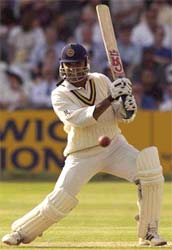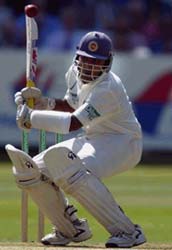Determination and style
Daniel Laidlaw
Sri Lanka's two greatest threats to beating England in the current Test
series were 1) losing Muralitharan and 2) floundering on England's seaming
early-season wickets. Losing Murali to injury was unfortunate but outside
their control. The latter, though, they could do something about.
The script for the first Test, the legitimate fear, was that England would
win the toss and bowl first on a seaming green monster and Sri Lanka would
destruct in a series of injudicious shots, unable to combat the conditions.
Well, the green monster didn't materialise but nor, more importantly, did
the injudicious shots.
It is quite ironic that after finally being granted a three-Test series in
England, the hosts' generosity should extend to preparing a batting pitch
comfortable for the visitors. It is perhaps some justice after being ignored
for so long, as it allowed the Sri Lankan batsmen to prove that they could
indeed play.
Indian coach John Wright said after the third Test that shot selection had
let his team down, and that it was the most important issue for his batsmen
to work on. It applies even more so to Sri Lanka's batsmen in England, where
one might reasonably have envisioned a surfeit of edges behind the wicket as
they chased the moving ball.
Despite the initially favourable conditions, Sri Lanka clearly came well
prepared. Knowing how crucial shot selection would be to making runs, Lankan
coach Dav Whatmore wrote back in September last year that the key to
surviving against the moving ball was to not play away from the body.
"Playing and missing is fine, but you must not follow the ball. Survival
against the moving ball requires a more compact technique and the more
practice players have under those conditions the better they will become."
 It's another matter to put this discipline into practice, but so far they
have. Batsmen like Mahela Jayawardene, who score their runs quickly or
stylishly, are invariably termed talented. Sometimes, the tag of "talented"
when applied to batsmen is almost a backhanded compliment for the qualities
it implies they don't have - grit, solid temperament, proper technique.
Words like "determination" and "character" are less used than they possibly
should be in conjunction with those who are deemed talented.
It's another matter to put this discipline into practice, but so far they
have. Batsmen like Mahela Jayawardene, who score their runs quickly or
stylishly, are invariably termed talented. Sometimes, the tag of "talented"
when applied to batsmen is almost a backhanded compliment for the qualities
it implies they don't have - grit, solid temperament, proper technique.
Words like "determination" and "character" are less used than they possibly
should be in conjunction with those who are deemed talented.
Marvan Atapattu and Mahela Jayawardene, then, should not be termed talented
batsmen. Though they clearly are, it's not their outstanding feature, or at
least wasn't in their centuries at Lord's. The hallmarks of their innings,
like that of Sri Lanka's batting collectively in recent times, was their
professionalism and application.
Fast-scoring batsmen generally aren't called professional or committed,
because they make it look either too easy or too risky. Professionalism,
determination, usually entails an overt display of effort; a struggle. But
if you're good enough to go beyond that, retaining the fundamentals along
with the style, then the credit given isn't necessarily what it deserves.
Just as it's better to be lucky than good, so it is better to be stylishly
effective and receive less attention for your fighting qualities than be
noticeably gritty, scrappy and make less runs. When you have a team with
batsmen consistently averaging in the 40s, then you are no longer simply
flashy or exciting. There's a word for playing determinedly with style -
class. Atapattu and Jayawardene demonstrated it.
On day one of the first Test, Atapattu and Jayawardene did not attempt to
take what the English bowlers were not prepared to give. They scored
quickly, yet without seeking to force the pace. Attractive batsman though he
undoubtedly is, the feature of Jayawardene's innings was his temperament and
control. Well set on a hundred in the last session, he was plainly furious
to concede his wicket tamely. Punishing the opposition when they are down is
another sign of professionalism. This time he missed out, but the intent was
evident.
Atapattu, with his economy of movement, was also stylishly effortless, yet
it was his compactness and straight driving that appealed most. Playing
compactly served Atapattu well, as it should for an opener. He did not miss
out, seeing Sri Lanka through the best part of four sessions.
 The criticism against the likes of Jayawardene and Atapattu is that they
have built their records on flat tracks at home, that they haven't performed
overseas. A quick glance at their averages reveals Jayawardene averages 32
away against 49 overall, and Atapattu 28 against 38. However, there is also
an imbalance in the number of home vs. away matches played: Jayawardene has
played 29 of his 41 at home and Atapattu 34 of 55.
The criticism against the likes of Jayawardene and Atapattu is that they
have built their records on flat tracks at home, that they haven't performed
overseas. A quick glance at their averages reveals Jayawardene averages 32
away against 49 overall, and Atapattu 28 against 38. However, there is also
an imbalance in the number of home vs. away matches played: Jayawardene has
played 29 of his 41 at home and Atapattu 34 of 55.
That their weakness may be against fast, short-pitched bowling on bouncy
tracks or prodigious seam and swing is not surprising. Mainly, it's a
question of experience, and more away tours to places where those conditions
are prevalent should see those weaknesses gradually diminish. But it is also
a little disingenuous to say 'Oh, they can make runs on turning wickets at
home and easy-paced wickets abroad, but just wait until they get on seaming
pitches with lots of bounce when the ball is swinging!' It would be holding
all batsmen to impossibly high standards to ask them to flourish in all such
conditions.
It's not easy to change perceptions. Steve Waugh has played almost 150
Tests, made more than 9000 runs and beaten down some of the world's best
fast bowlers, yet they still persist in bowling short at him too frequently.
Once you're marked, you're marked for a long time, regardless of whether the
tag continues to fit.
One suspects Sri Lanka aren't yet perceived as a quality team, because they
have yet to conclusively prove it. But if seaming wickets are not prepared
and the batsmen continue to apply themselves determinedly, they'll have gone
some way towards confirming it. Then if the seamers were to deliver some
inspired bursts before Murali returns, England could just find the Lankans
hard to stop.
More Columns
Mail Daniel Laidlaw